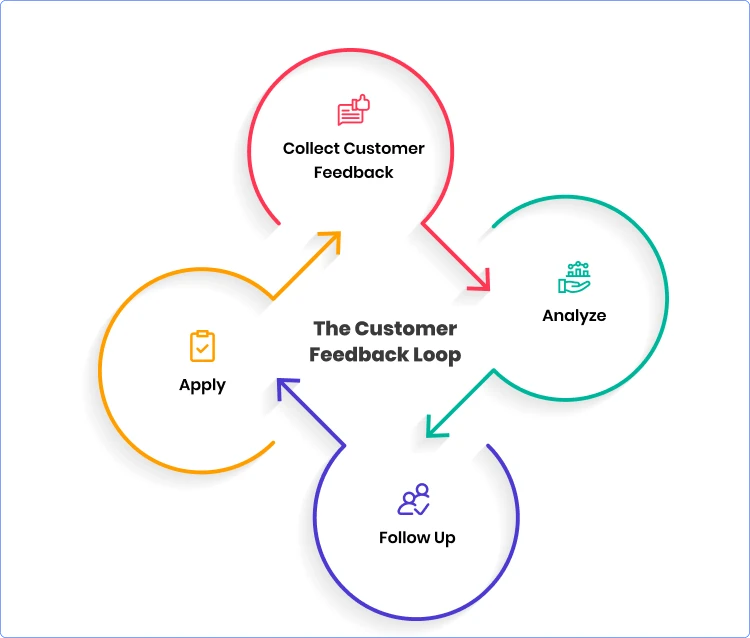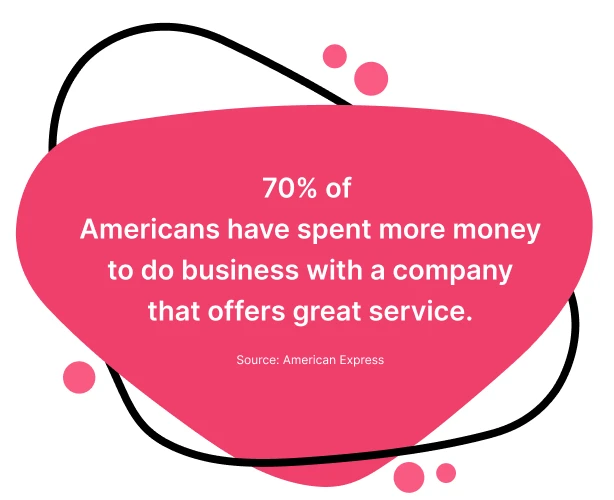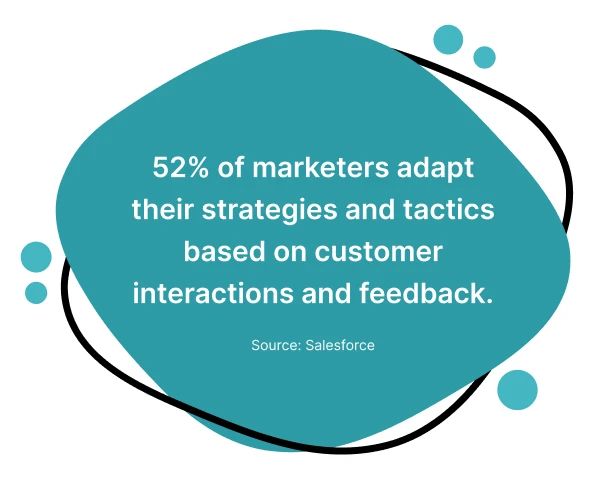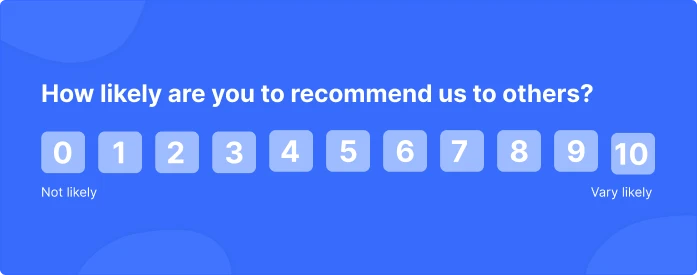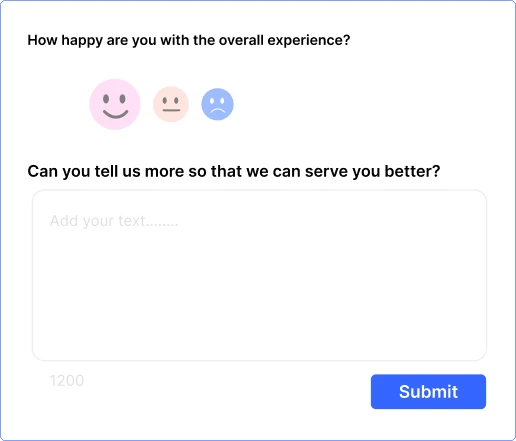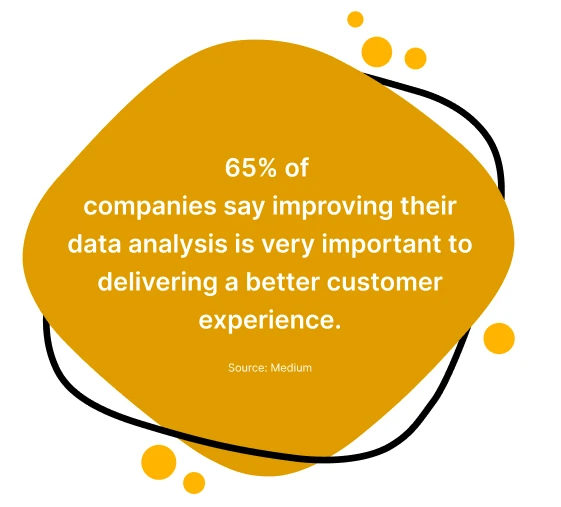What is a Customer Feedback Loop and How to Create One?
- April 8, 2024
- 16 mins read
- Listen

Table of Content
Have you ever had a product or service experience that left you thinking, “Wow, I wish they knew how I felt about this”? Well, you’re not alone! Many of us feel the same. The best part is companies nowadays are also eager to understand how we like their product offerings. And that’s where the magic of the customer feedback loop comes into play.
If you don’t know what went wrong, you can’t fix it. Without proper customer feedback, you will fail in the long run for sure. Here the best part is many customers are even ready to help you out.
The customer feedback loop isn’t just about venting frustrations. It’s a two-way street where businesses actively listen, engage, and iterate based on customer feedback. It’s a powerful tool for driving innovation, improving customer satisfaction, and building genuine connections between brands and their loyal fanbase.
In this article, we’ll explain what a customer feedback loop is and why it’s super important for your business. We’ll also show you how it can turn your customers’ feedback into something really valuable for your product or service. So, keep reading!
What is a Customer Feedback Loop?
A customer feedback loop is like a cycle that never stops. It’s a system where businesses listen to what customers say about their products or services, learn from it, and then make improvements. Think of it as a continuous learning process where customers are the teachers, and businesses are the students who want to get better.
Your customers will have both positive and negative feedback regarding your offerings. Taking those seriously will help you to get detailed insights on how the users are liking your products and what are the improvement areas that you need to work on. You should consider feedback from customers for not only product improvement but also for developing new services and strategies to improve the overall functionalities of your brand.
How to Create a Customer Feedback Loop?
You can divide the customer feedback loop into basic 4 stages:
- Collecting feedback from your customers
- Analyzing the feedback
- Applying the changes and testing
- Follow up
Next, let’s go through each of these stages to understand the concept in a better way:
1. Collecting Feedback from Your Customers
It’s really important to listen to what people say about your business so you can keep getting better. To gather feedback from customers, you need to ask for it. There are lots of ways to do this:
- Ask them to fill out survey forms
- Look at what people say about you online
- Chat with customers when they’re on your website
- Keep track of the call records you get
- Keep an eye on social media to see what people are saying
Consider reaching out to your customer support team to gather insights on recurring issues or complaints as they are the ones who handle customers on a daily basis. The main goal of all this is to make your customers happier and make your business better.
2. Analyzing the Feedback
After you have gathered a good amount of customer feedback, it’s time to understand the problems and take action. Your survey tools, live chat, phone calls, and other means of feedback collection platforms offer dashboards from where you can fetch detailed reports.
Once you start analyzing the feedback, you will find out some patterns. For example, among the no-so-satisfied customer comments, you may find some persisting problems that your customers are talking about repeatedly. You need to find out those issues and work more for further betterment.
3. Applying the Changes and Testing
Once you’ve looked at your feedback data, it’s time to try things out, especially if it’s something like improving your pricing page to make it clearer. You can test two different versions to see which one works better and gets more positive feedback. If the new version is better, great! But if not, you might need to go back to the drawing board and try again.
It’s also a good idea to ask your customers for more feedback, especially those who already gave suggestions or corrections. Send them an email to let them know about the updates you’ve made and ask for their thoughts again. This step is really important in the third part of your feedback loop.
4. Follow Up
Now, it is time to close the feedback loop and follow up with the customers who have provided their feedback.
You have to personally get in touch with them for the latest updates. Acknowledging the feedback is something that you should do but taking steps based on that feedback is a completely different thing that you must follow.
For example, if customers are telling you to resolve an existing bug, a broken link, or add new integrations let them know personally through emails that you have made all the changes suggested by them.
It not only shows that their feedback is important for your brand, but they also feel heard. While responding to customer emails, request those who have given you negative reviews to change their comments as you have already fixed those issues. Similarly, you can ask the ones who have given positive feedback if you can use their reviews as social proof.
Why the Customer Feedback Loop is Important for Your Business?
Now that you understand what the feedback loop is, you might wonder why it’s important. Here are five important reasons why paying attention to feedback from users is more than just a good idea:
-
Understand Your Customers in a Better Way
Even if you’ve done a lot of research and created detailed profiles of your buyers, nothing is better than hearing directly from your customers what they feel about your brand and the product offerings. Their feedback gives you a better understanding of who they are, their journey with your company, and what they want from you.
By getting to know your customers better, you can create experiences that resonate with them, meeting their needs head-on. And when you do that, they’ll stick around and buy more from you.
-
Indicates the Level of Customer Satisfaction
You’re probably curious about how happy your customers are with your products or services. Well, you can find out by using surveys. They’ll tell you how satisfied your customers are and what needs to be improved.
For instance, if you run an online store selling sports accessories and your customers keep complaining about late deliveries, that’s valuable feedback. With that information, you can make improvements and turn those not-so-satisfied customers into happy ones.
-
Helps to Get More Happy Customers
When customers know that you are listening to them, and taking their feedback seriously, they feel important, and that’s the key to keeping them around for a long time. When you regularly ask for feedback, your customers also feel comfortable suggesting changes or updates they want to see. This makes them less likely to stop using your product.
And when you upgrade your product offerings based on their feedback, it makes them even happier. It’s a win-win situation!
-
Your Support Team Gets Better Training
Customer feedback serves as a dual-purpose tool, aiding in both enhancing your offerings and refining the skills of your support team. Your customer support representatives serve as the frontline ambassadors of your brand, engaging with numerous customers daily.
They are the superheroes with invaluable insights into customer sentiments, an ideal source for understanding your brand’s perception. So, continual training is essential for them to remain updated and deliver the best services consistently.
-
Increases Brand Loyalty
The customer feedback system allows you to understand your customers’ needs, preferences, and pain points better. By addressing these through product improvements or service enhancements. Always remember that a brand that actively listens to and acts upon customer feedback is perceived as caring, responsive, and committed to continuous improvement. Such positive perceptions contribute to building strong brand loyalty among customers.
Types of Customer Feedback
Customer feedback is important and there is no doubt about that. But there are different types of feedback that you can together based on what you want to know from your customers. Here’s one basic list covering all the important segments.
-
Metrics on Customer Loyalty
These metrics provide valuable insights into customer loyalty and help businesses assess the effectiveness of their efforts in building long-term relationships with their customer base.
You can get such info through Net Promoter Score (NPS), customer retention rate, repeat purchase rate, churn rate, etc.
-
Sales Feedback
Here customers express their thoughts about the interaction they had with your sales team and how they felt during the whole buying process. This feedback is really important because it helps the salespeople and leaders better understand what they do and understand their potential customers more effectively.
You can gather this feedback by asking customers directly after they’ve made a purchase through live chat, phone calls, or emails. You can also follow up with people who were considering buying but didn’t end up making a purchase.
-
Customer Satisfaction Metrics
Want to know how satisfied your customers are with your services or personal engagements? 70% of purchasing experiences hinge on the customers’ perception of how they are treated and 78% of customers have abandoned purchase because of a negative experience.
Simple survey questions like “How satisfied are you with the services” or “How likely are you to continue using [Product/Service] in the future?” can give you the answers. You can run surveys to find out the answers or collect such comments from comment boxes, post-purchase forms, etc.
Customer satisfaction feedback examines how satisfied your customers are with your products, services, and other interactions with your brand. This type of feedback looks at both functional and emotional metrics, e.g. answers to questions like “How did you use…?” and “How did you feel about…?”
These metrics help you gauge customer satisfaction levels, identify improvement areas, and track the effectiveness of your efforts in meeting customer needs and expectations.
-
Customer Service Feedback
Here, you will get to know how excellent your customer service is.
It focuses on how customers feel about the help they get from a service or support representative. This feedback is super important for making your customer service better. You can get instant customer service feedback on live chat platforms. Apart from that email and phone surveys are also good options to opt for.
-
Information on Customer Preferences
This feedback tells you what your customers prefer. Among all your offerings, which are the ones that your customers like the most? This will help you to position your most loved products in a better way.
Surveys, customer reviews, purchase history, and different focus groups are some of the great ways to collect such kind of customer feedback.
How to Collect Customer Feedback?
As per research by Microsoft, a majority of consumers, around 77%, hold a more positive view of brands that actively seek and incorporate customer feedback. So, collecting feedback is something you should do regularly, and it’s a good idea to use different surveys and methods for the best results. Let’s talk about some of the best ways to do this.
-
Website Surveys
One way to get feedback that works well is through surveys. They’re popular and easy to use, and many of us find them convenient. Targeted website surveys are especially good because they are designed to fit in smoothly with the website and are easy to understand.
You can ask different kinds of questions and target specific groups, like people who are interested in a website redesign or those who have just made a purchase. However, some customers don’t like pop-up surveys, so it’s important to make sure pop-ups don’t bother them while they are on your website.
-
Through Live Chat Interactions
There are many live chat platforms available in the market that let you get instant feedback from your customers. How? After every live chat session with your customers, you can share a feedback form with them and get their feedback. It will be instant, and the best part is you can handle all the feedback and interactions from a single place.
The feedback form is completely customizable giving you the chance to create it as per your requirements.
-
Feedback Widgets
Feedback widgets are invaluable tools for businesses seeking to understand and improve their customers’ experiences. These widgets, often integrated seamlessly into websites or applications, provide a convenient way for customers to share their thoughts, opinions, and suggestions in real time. Whether it’s positive feedback, constructive criticism, or feature requests, these widgets serve as a direct line of communication between businesses and their clientele.
Feedback widgets are useful for reporting issues and gathering potential leads. They’re triggered by your customers, so the feedback you receive is closely tied to their experiences. However, unlike website surveys, their targeting is more limited because they only appear where they’re installed.
-
Net Promoter Score (NPS)
Net Promoter Score (NPS) is a popular method used by businesses to gather customer feedback and measure customer satisfaction. It’s a straightforward yet powerful tool that provides valuable insights into how likely customers are to recommend your company’s product or service to others.
It’s one of the most commonly used survey formats, and you can easily create your own. Here’s an example: You ask customers how likely they are to recommend you to others, and they rate it from 1 to 10. 1 means very unlikely, and 10 means very likely. This helps you understand how satisfied they are with your services.
-
Customer Satisfaction Score (CSAT)
Customer Satisfaction Score (CSAT) is a widely used method for collecting feedback from your customers to gauge their satisfaction levels with a product or service. It offers valuable insights into how well your products are meeting customer expectations and where improvements may be needed.
How does CSAT work? You can ask your customers simple questions like:
- How satisfied are you with your experience?
- How would you rate your satisfaction with our product/service?
The questions are usually provided with a scale, often ranging from “Very Dissatisfied” to “Very Satisfied,” or from 1 to 5 or 1 to 10. Once your customers provide their ratings, you need to calculate the overall Customer Satisfaction Score. This score reflects the percentage of satisfied customers, typically calculated by dividing the number of satisfied responses by the total number of responses and multiplying by 100.
-
Questionnaires
Questionnaires provide structured methods for gathering data, insights, and opinions, allowing you to understand your customer needs, preferences, and satisfaction levels more comprehensively.
Questionnaires typically consist of a set of structured questions that you can design to gather specific information from the respondents. These questions can cover various aspects of the customer experience, such as product usability, customer service quality, pricing satisfaction, and overall satisfaction levels.
These are simple and user-friendly, offering a variety of question options and targeting features. However, because they tend to be longer, you might receive fewer responses.
-
Social Media Monitoring
It is a valuable method for collecting customer feedback by tracking and analyzing conversations, mentions, and interactions across various social media platforms. It involves using specialized tools and techniques to monitor brand mentions, comments, reviews, and sentiments expressed by customers.
These comprehensive social media management tools are equipped with advanced social media listening capabilities. It allows you to monitor brand mentions, keywords, hashtags, and trends across multiple social media channels in real-time.
Here are some popular social media listening tools:
- Hootsuite
- Google Alert
- Mention
- Sprout Social
- Talkwalker
Customer Feedback Loop Examples
Feedback from your customers, whether good or bad, is great for showing you where your business can improve. Customers will let you know what needs fixing and might even give you ideas on how to do it.
Here are some examples to help you understand how the customer feedback system works in real life.
1. Customer Feedback: Your Customer Support is not Satisfactory
The Problem: You own an online store that sells packaged food items. One of your customers tried to call you to let you know that he ordered some packets of ready-to-eat noodles weeks ago and is still waiting for the products to be delivered.
When the customer called your customer service, he had to wait a long time to speak to an agent. Even though he eventually got an estimated delivery time, it took a lot of effort to get a resolution. The customer expressed dissatisfaction in his CSAT survey for this reason.
The Feedback Loop: First of all, thank the customer for his feedback and create a customized message for him.
Here’s How You Can Respond:
- Thank the customer for his feedback and make sure your response feels personal.
- Let him know that you’re going to investigate the issue and provide an update soon.
Steps You Can Take:
- Look into whether this is a one-time problem or an ongoing issue by analyzing your feedback patterns.
- Offer compensation for the inconvenience, such as a discount on his next purchase.
- Inform your customer service team about the problem.
- Consider adding a new customer service option, like a chatbot, to help reduce the workload on other agents.
- Inform the complaining customer and others about the improvements you’re making based on the feedback.
2. One of Your Products is a Hit Among Customers
Situation: When multiple customers give positive feedback, saying your product is great and they are getting benefited from it. You need to understand that you are on the right track.
The Feedback Loop: First of all, thank each one of them for sharing their valuable feedback and appreciating your product.
Steps You Can Take:
- Thank your customers for their feedback.
- Ask these customers for ideas on how to make your products even better.
- Invite them to join a group where they can share thoughts on future products.
- Ask for their permission to use their reviews on your website or other social media platforms.
- Let your product team know about the feedback so that they get motivated and keep improving.
How REVE Chat Helps to Get Instant Customer Feedback?
Gone are the days of waiting endlessly to gather feedback from your valued customers. While surveys certainly have their place, live chat platforms allow you to receive feedback in real time. REVE Chat is one of the best live chat platforms available in the market which makes it possible for you.
REVE Chat isn’t just another live chat tool; it’s an omnichannel solution that provides instant support across web, mobile, and various social media platforms. What sets it apart is its ability to seamlessly integrate customizable feedback templates into each live chat interaction, ensuring you capture valuable insights from your customers effortlessly.
But that’s not all – REVE Chat also offers an AI-powered smart chatbot that makes the customer feedback system completely automated. Want to give it a try? SIGN UP for its 14-day FREE TRIAL today!

